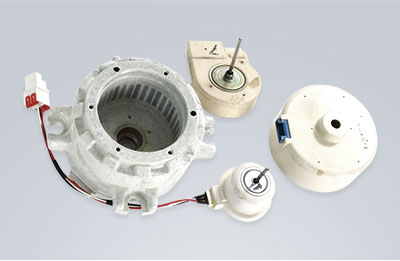BMC (Bulk Molding Compound)
Short for Bulk Molding Compound, BMC is a thermosetting composite molding material in bulk form with excellent formability. BMC is created by evenly dispersing and kneading glass chopped strands into a compound that is made by adding additives such as low profile agents, internal lubricants, and fillers to unsaturated polyester resin, which serves as a base.
-
The Characteristics
of BMC- 1) Since it has excellent fluidity, BMC makes it possible to mold large products as well as products with complex shapes.
- 2) BMC has excellent mechanical and electrical properties.
- 3) Due to its excellent dimensional stability, products molded using BMC have great levels of dimensional accuracy and have smooth surfaces (no sink marks).
- 4) BMC has excellent corrosion resistance and excellent weatherability.
- 5) BMC has high heat deflection temperatures and suffers little thermal aging.
- 6) BMC has an excellent self-extinguishing capability, and there are even high-grade types that have achieved a UL 94 V-0 rating.
- 7) BMC has excellent surface gloss and can be created in various colors.
- 8) BMC has an excellent vibration damping capability (motor encapsulation).
-
Handling Precautions
- 1) BMC contains a large amount of volatile styrene monomer. As a result, when volatilized, it becomes stiffened and can cause molding defects.
- 2) BMC comes wrapped in nylon film, and damaged packaging and remaining packing materials must be sealed with nylon film or al-laminated film.
- 3) As the pot life of BMC is less than one hour, it is recommended to use BMC immediately after opening its package.
- 4) It is recommended that BMC be stored in a cold dark place at a temperature of 20℃ or below. If BMC is stored in a place whose temperature is 10℃ or more above/below 20℃, the BMC’s pot life decreases by half. (Normally, BMC stored in a cold dark place at a temperature of 20℃ lasts for about two months.)
- 5) The packaging of BMC is often damaged during loading, so please be sure not to stack BMC in more than five layers.
-
Molding Methods
Compression molding, injection molding, or transfer molding is chosen depending on the shape, size, and quantity of the molded product.
| Method | Compression molding | Transfer molding | Injection molding |
|---|---|---|---|
| Use | Common products requiring strength | Products requiring insert-molding | Mass-produced products and areas requiring precision |
| Merits | Small quantity batch production Reduction of molding costs | Insert-molding/encapsulation The cavity can be widened. | Capable of mass production Excellent precision Excellent production processability |
| Molding conditions |
Forming temperatures: 150-170℃ Forming pressure: 100-200㎏/㎠ Clamping time Primary: 2-3 sec. Secondary: 2-3 sec. Tertiary: 5-10 sec. Molding time: 40-60 sec./mm |
Material preheating:40-70℃ Forming pressure: 130∼150℃ Forming pressure: 30-100㎏/㎠ Injection time: 5-15 sec. Molding time: 40-60 sec. |
Forming temperatures: 150-180℃ Forming pressure Primary: 500-1000㎏/㎠ Secondary: 300-500㎏/㎠ Molding time: 1-5 sec. Holding pressure time: 10-20 sec. Molding time: 20-30 sec. Screw RPM: 50-100 |
Introducing Our BMC Products

Our BMC products in this line are used as encapsulants for solenoid coils, bobbins, and transformers as well as for various BLDC motors, such as those used in washing machines, air conditioners, refrigerators, etc. Their excellent fluidity makes low-pressure molding possible, so there is no coil deformation and breakage. In addition, because of their excellent dimensional stability, products are guaranteed to have accurate dimensions and roundness, and with no cracks or deformations.
Characteristics
- 1) With minimum levels of mold shrinkage, they have excellent dimensional accuracy and are crack- and distortion-free.
- 1) They have small linear expansion coefficients, so there is no deterioration of parts due to changes in the environment.
- 3) Their excellent fluidity makes low-pressure molding (70Kg/㎠ or lower) and low-temperature molding (120℃ or lower) possible, and therefore, no deformation or breakage is caused to coils.
- 4) Because of the above characteristics, the inserted component receives only a little amount of load, and its performance is improved.
- 5) Because of their excellent formability, they are highly suitable for both transfer molding and injection molding.
- 6) Being molded in one piece, they are very effective in reducing vibrations and noise from various types of motors.
BMC Automotive Product Features Table
Grade
Characteristic
Application
Molding method
Data sheet
SNS-515
Non-shrinkage and
UL-certified (V-0 rated)
Various motor housings
Transfer molding and injection molding
View technical sheets
Request MSDS’s
SN-515
Non-shrinkage and general products
Various motor housings
Transfer molding and injection molding
SLS-516
High strength and good water resistance
Air conditioner coils
Pump motors
Transfer molding and injection molding
SNS-525
Non-shrinkage and
UL-certified (5VA,RTI 130)
Motor housings for various cars
Transfer molding and injection molding
Major Customers
| Grade | Characteristic | Application | Molding method | Data sheet |
|---|---|---|---|---|
| SNS-515 | Non-shrinkage and UL-certified (V-0 rated) |
Various motor housings | Transfer molding and injection molding |
View technical sheets Request MSDS’s |
| SN-515 | Non-shrinkage and general products | Various motor housings | Transfer molding and injection molding | |
| SLS-516 | High strength and good water resistance | Air conditioner coils Pump motors |
Transfer molding and injection molding | |
| SNS-525 | Non-shrinkage and UL-certified (5VA,RTI 130) |
Motor housings for various cars | Transfer molding and injection molding |
Samsung Electronics, New-motech, SPG, O-sung Electronic machinery co.ltd, POSCO TMC.





